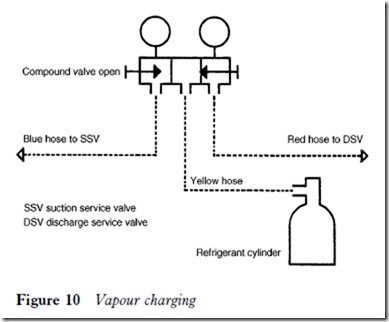Vapour charging
A slight loss of refrigerant is recognized by ‘bubbles’ in the liquid-indicating sight glass installed in the liquid line of a system, a loss of performance, partial frosting of the evaporator and lower than normal operating pressures. Refrigerant may be added in vapour form to the low side of the system if the refrigerant is azeotropic such as R502. This means that it reacts as a single substance refrigerant.
The zeotropic refrigerant blends do not react in a similar manner and they should be added to a system in liquid form. This subject is covered in more detail in Chapter 17.
The procedure for vapour charging is as follows (Figure 10):
1 Fit gauges, set the service valves to operating positions and operate the plant.
2 Obtain a service cylinder of the correct refrigerant: this can be verified from the equipment log, the compressor nameplate or the label on the expansion valve.
3 Connect the yellow hose to the centre connection on the manifold and to the service cylinder.
4 Open the valve on the service cylinder, loosen the connection on the centre hose on the manifold and purge air from the hose.
5 Tighten the hose connection and set the suction service valve to the midway position.
6 Open the compound gauge valve on the manifold slowly, and regulate the refrigerant into the system at an approximately average suction pressure (e.g. 30 psi or 2 bar for R12).
7 Observe the liquid-indicating sight glass and, when the bubbles cease, close the compound gauge valve on the manifold. If bubbles return intermittently after a short time, add more refrigerant. When bubbles have ceased completely the operating pressures will have returned to normal and the evaporator will be fully frosted.
![]() A further check on the refrigerant charge is described on pages 33 8.
A further check on the refrigerant charge is described on pages 33 8.
When vapour charging a system with an azeotropic refrigerant such as R502 the refrigerant cylinder must always be kept in a vertical position to prevent the possibility of liquid refrigerant from entering the compressor. This can create a dynamic pressure when the compressor starts, causing damage to valves or may even break piston connecting rods and damage pistons. The liquid refrigerant will also flush lubricating oil from bearing surfaces.
The main disadvantage of vapour charging to the low side of the system is that it is a comparatively slow process, especially during low ambient temperature conditions and when the system requires a large operating charge. A large compressor will quickly reduce the suction pressure. The cylinder will become cold and, if the low pressure condition is prolonged, the cylinder will frost up.
Hermetic and semi-hermetic motor compressors may be suction vapour cooled; that is, they may rely upon suction vapour returning to the compressor in sufficient volume to cool the motor windings. It is possible that the low volume of vapour entering the compressor during the charging process will not be adequate for motor cooling.
The charging process can be speeded up by applying swabs dipped in warm water to the refrigerant cylinder. Never heat cylinders with a blowtorch or immerse them in boiling or very hot water.
A rapid charger is available. This device, fitted between the hose and the cylinder, acts as a restrictor or limit valve, maintaining a higher constant pressure in the cylinder and preventing early frosting. The vapour passing through the device is less superheated when it reaches the compressor, so less time is taken to charge the system.
